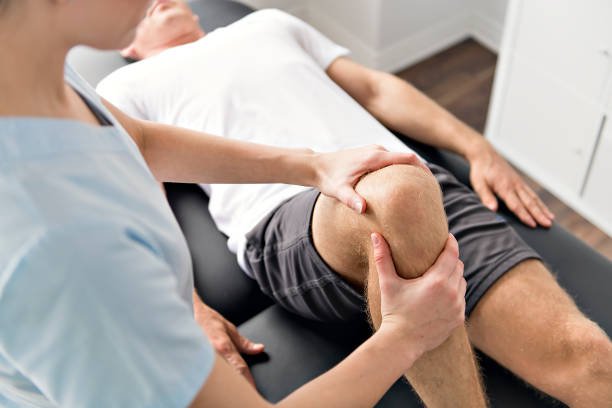INTRODUCTION
The sensation the examiner “feels” in the joint as it reaches the end of the end range of motion is called End feels
When assessing passive movements, the examiner should apply overpressure at the end range of motion to determine the quality of end feels
A proper care must be taken while testing end feel, to be sure that severe symptoms are not provoked
If the patient is able to hold a position at the end of physiological range of motion (end range of active movement) without provoking symptoms or if the symptoms ease quickly after returning to the resting position, then the end feel can be tested
A proper evaluation of end feel can help can help the examiner to assess the type of pathology present, determine a prognosis for the condition, and learn the severity or stage of problem
By determining if pain or restriction is the main problem, the examiner can determine if a more gentle treatment should be given (pain predominating) or a more vigorous treatment (restriction predominantly)
The end feel sensations that the examiner experiences are subjective, so intrarater reliability tends to be good, whereas interrater reliability is poor
Normal End feels
There are three classic normal end feels
Bone-to-bone = This is the ” hard ” unyielding sensation that is painless
most common example of bone to bone endfeel is elbow extension
Soft-Tissue Approximation = There is yielding compression (the mushy feel) that stops further movement.
examples are elbow and knee flexion, in which movement is stopped by compression of the soft tissue, primarily the muscles.
Tissue Stretch = there is a hard or firm type of movement with a slight give
Towards the end of ROM, there is a feeling of springy or elastic resistance.
The normal end feel has a feeling of rising tension or stiffness. this changing tension has led to this and feel sometimes being divided into types:
- elastic (soft)
- capsular (hard)
This feeling depends on the thickness and type of tissue being stretched, and it may be very elastic, as in the Achilles tendon stretch, and slightly elastic as in wrist flexion
A hard end feel is firm with a definite stopping point, whereas soft end feel implies a softer end feel without a definite stopping point
Tissue stretch is the most common type of normal end feel; it is found when the capsule and ligaments are the primary restraints to movement.
Examples of tissue stretch are lateral rotation of shoulder and metacarpophalangeal joint extension

Abnormal End feels
there are five classic abnormal end feels
1. Muscle spasm
This end feel is invoked by movement, with a sudden dramatic arrest of movement often accompanied by pain
It is sudden and hard and also called as “Vibrant Twang“
It can also be divided into different parts such as
- Early muscle spasm
- Late muscle spasm
- Spasticity
Early muscle spasm appears at the beginning of the range of motion, often immediately after movement begins. This type of spasm is linked to inflammation and is commonly observed in acute conditions.
Late muscle spasm occurs at or near the end of the ROM. it is typically triggered by joint instability, with movement leading to irritation and an abnormal end feel
Spasticity is slightly different and is seen with upper motor neuron lesion. it is the form of muscle hypertonicity that offers increased resistance to stretch involving primarily the flexors in the upper limb and extensors in lower limb. the modified ashworth scale is sometimes used to measure, but its reliability has been questioned
The tight muscle may give its own unique end feel. this is similar to tissue stretch, but it does not have as great an elastic feel
2. Capsular
While this end feel resembles a tissue stretch, it happens in an unexpected location, indicating an abnormal restriction within the joint (i.e. it occurs earlier in the ROM), and it tends to have a thicker feel to it.
ROM is reduced, and the capsule can be postulated to be at fault
It is again divided into hard capsular and soft capsular
Hard Capsular is in which the end feel has a thicker stretching quality. it is seen in chronic conditions or in full-blown capsular patterns. the limitations comes on rather abruptly after a smooth, friction-free movement.
Soft capsular is similar to tissue stretch end feel but with restricted ROM . it is more often seen in acute conditions with stiffness occurring early in range and increasing until the end of range is reached.
3. Bone-to-bone
This abnormal end feel is similar to the normal bone-to-bone type, but the restrictions occurs before the end ROM would normally occur or where a bone to bone would not be expected
example = cervical spine resulting from osteophyte formation
4. Empty
It is detected when movement produces considerable pain. the movement cannot be performed or stops because of pain, although no real mechanical resistance is being detected
Example = acute subacromial bursitis or a tumor
5. Spring Block
Similar to tissue stretch, this occurs where one would not expect it to occur; it tends to be found in joints with menisci
there is no rebound effect with a thick stretching feel although it is not as stretchy as hard capsular end feel, and it usually indicates an internal derangement within the joint
A springy block end feel can occur in the knee when a torn meniscus obstructs full extension, causing the joint to lock and preventing it from reaching full range of motion.